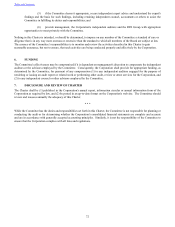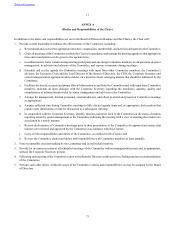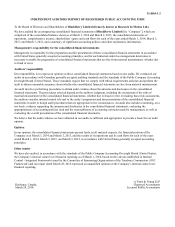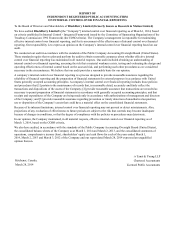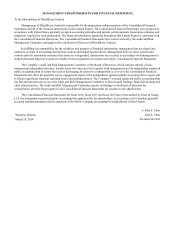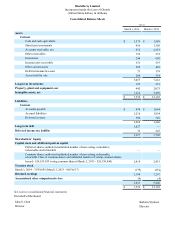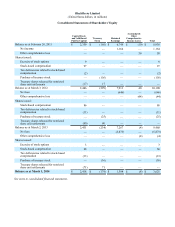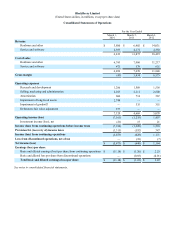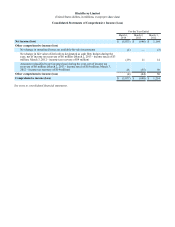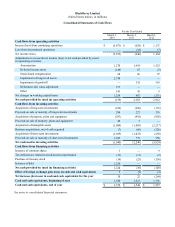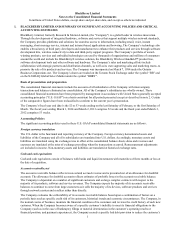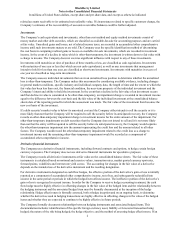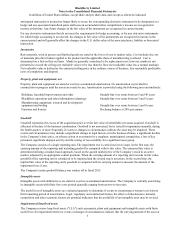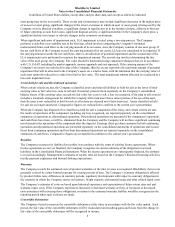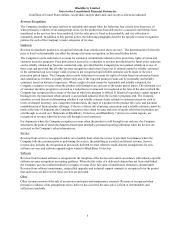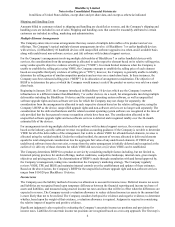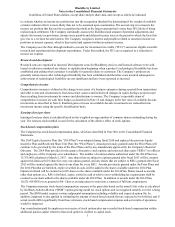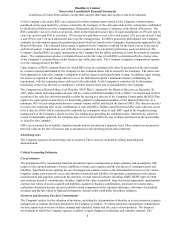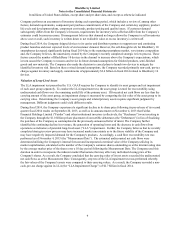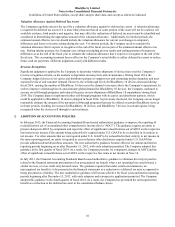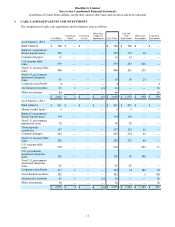Blackberry 2014 Annual Report Download - page 90
Download and view the complete annual report
Please find page 90 of the 2014 Blackberry annual report below. You can navigate through the pages in the report by either clicking on the pages listed below, or by using the keyword search tool below to find specific information within the annual report.1
BlackBerry Limited
Notes to the Consolidated Financial Statements
In millions of United States dollars, except share and per share data, and except as otherwise indicated
1. BLACKBERRY LIMITED AND SUMMARY OF SIGNIFICANT ACCOUNTING POLICIES AND CRITICAL
ACCOUNTING ESTIMATES
BlackBerry Limited, formerly Research In Motion Limited, (the "Company") is a global leader in wireless innovation.
Through the development of integrated hardware, software and services that support multiple wireless network standards,
the Company provides platforms and solutions for seamless access to information, including email, voice, instant
messaging, short message service, internet and intranet-based applications and browsing. The Company’s technology also
enables a broad array of third party developers and manufacturers to enhance their products and services through software
development kits, wireless connectivity to data and third-party support programs. The Company’s portfolio of award-
winning products, services and embedded technologies are used by thousands of organizations and millions of consumers
around the world and include the BlackBerry® wireless solution, the BlackBerry Wireless Handheld™ product line,
software development tools and other software and hardware. The Company’s sales and marketing efforts include
collaboration with strategic partners and distribution channels, as well as its own supporting sales and marketing teams, to
promote the sale of its products and services. The Company was incorporated on March 7, 1984 under the Ontario
Business Corporations Act. The Company’s shares are traded on the Toronto Stock Exchange under the symbol “BB” and
on the NASDAQ Global Select Market under the symbol “BBRY”.
Basis of presentation and preparation
The consolidated financial statements include the accounts of all subsidiaries of the Company with intercompany
transactions and balances eliminated on consolidation. All of the Company’s subsidiaries are wholly-owned. These
consolidated financial statements have been prepared by management in accordance with United States generally accepted
accounting principles (“U.S. GAAP”) on a basis consistent for all periods presented except as described in note 2. Certain
of the comparative figures have been reclassified to conform to the current year’s presentation.
The Company’s fiscal year end date is the 52 or 53 weeks ending on the last Saturday of February, or the first Saturday of
March. The fiscal years ending March 1, 2014 and March 2, 2013 comprise 52 weeks and the fiscal year ended March 3,
2012 comprises 53 weeks.
Accounting Policies
The significant accounting policies used in these U.S. GAAP consolidated financial statements are as follows:
Foreign currency translation
The U.S. dollar is the functional and reporting currency of the Company. Foreign currency denominated assets and
liabilities of the Company and all of its subsidiaries are translated into U.S. dollars. Accordingly, monetary assets and
liabilities are translated using the exchange rates in effect at the consolidated balance sheets dates and revenues and
expenses are translated at the rates of exchange prevailing when the transactions occurred. Remeasurement adjustments
are included in income. Non-monetary assets and liabilities are translated at historical exchange rates.
Cash and cash equivalents
Cash and cash equivalents consist of balances with banks and liquid investments with maturities of three months or less at
the date of acquisition.
Accounts receivable, net
The accounts receivable balance reflects invoiced and accrued revenue and is presented net of an allowance for doubtful
accounts. The allowance for doubtful accounts reflects estimates of probable losses in the accounts receivable balance.
The Company is dependent on a number of significant customers and on large complex contracts with respect to the
majority of its products, software and service revenues. The Company expects the majority of its accounts receivable
balances to continue to come from large customers as it sells the majority of its devices, software products and services
through network carriers and resellers rather than directly.
The Company evaluates the collectability of its accounts receivable balance based upon a combination of factors on a
periodic basis such as specific credit risk of its customers, historical trends and economic circumstances. The Company, in
the normal course of business, monitors the financial condition of its customers and reviews the credit history of each new
customer. When the Company becomes aware of a specific customer’s inability to meet its financial obligations to the
Company (such as in the case of bankruptcy filings or material deterioration in the customer’s operating results or
financial position, and payment experiences), the Company records a specific bad debt provision to reduce the customer’s


